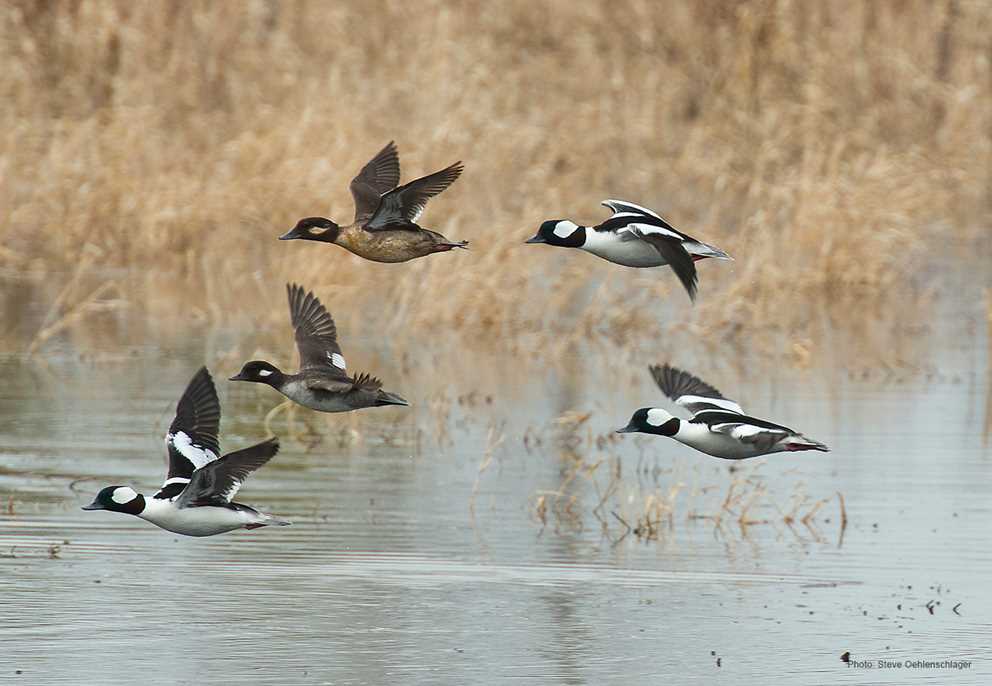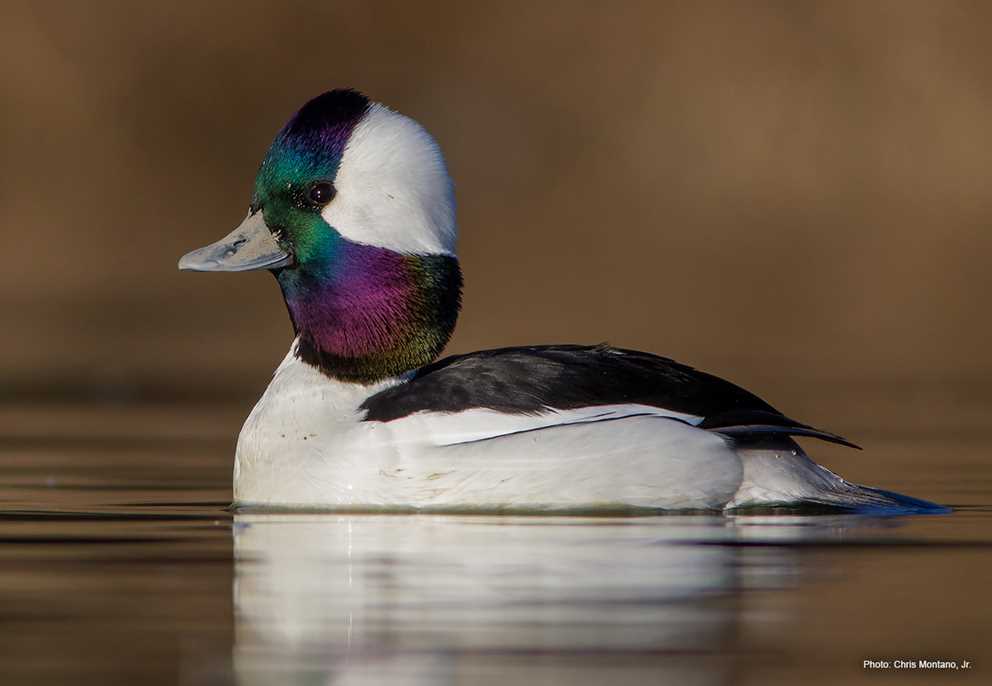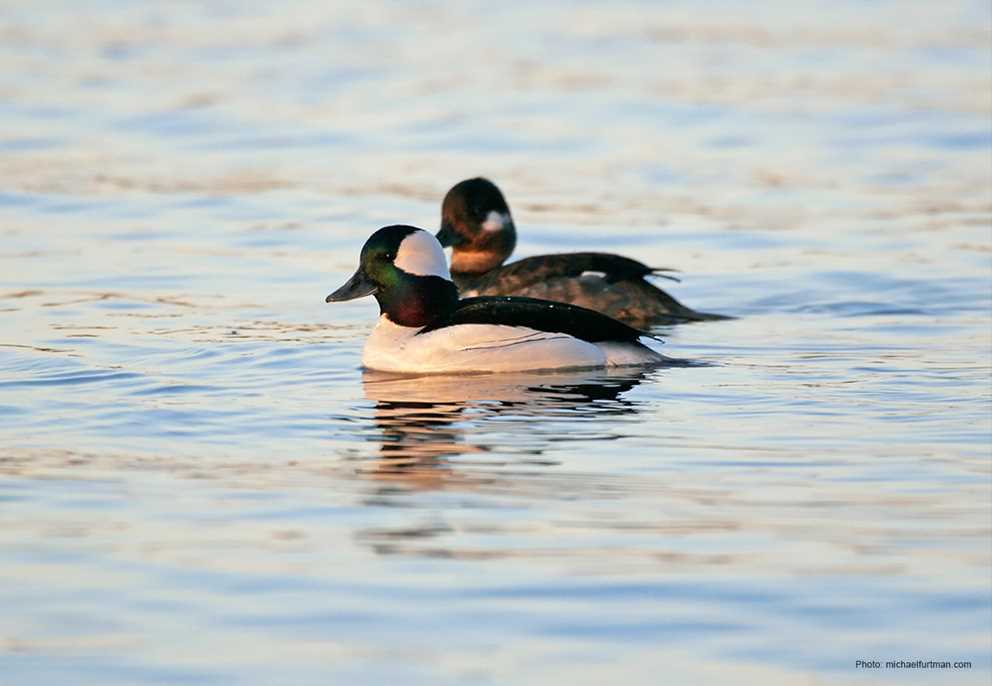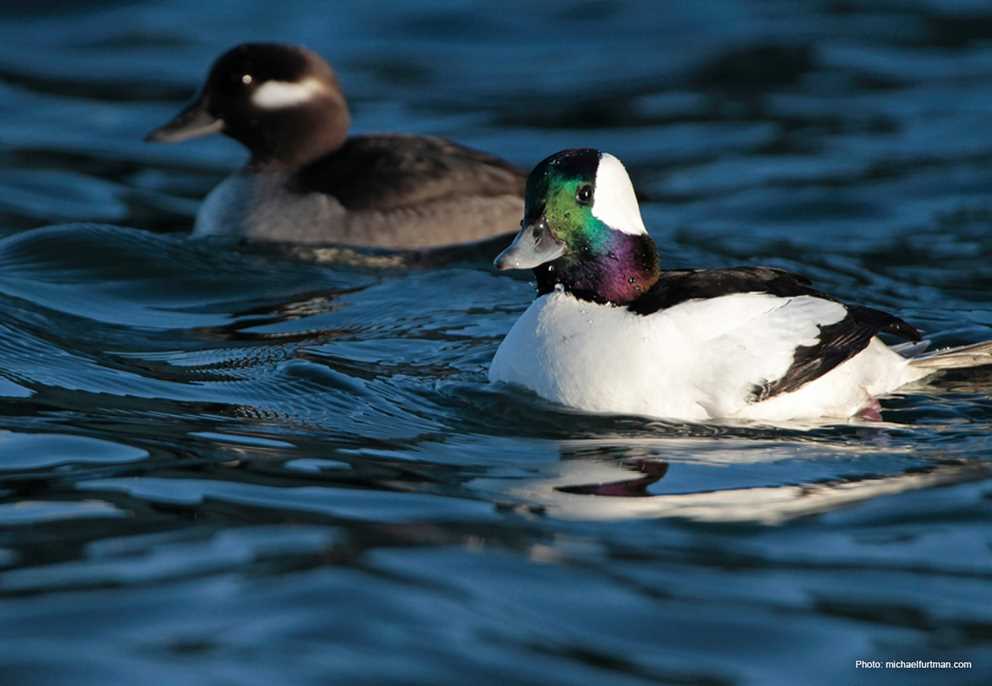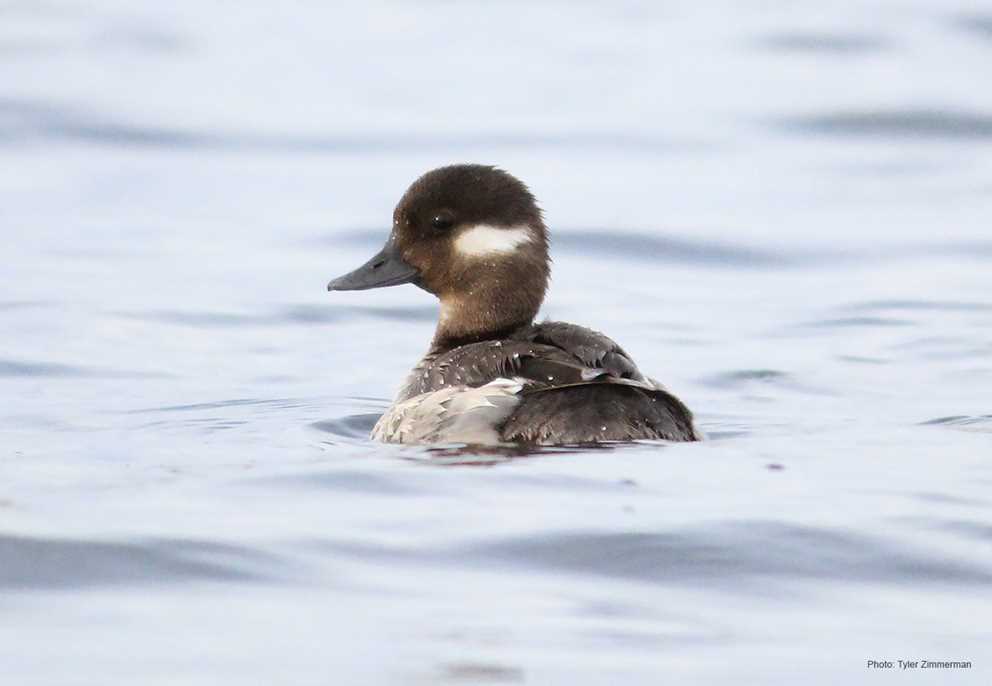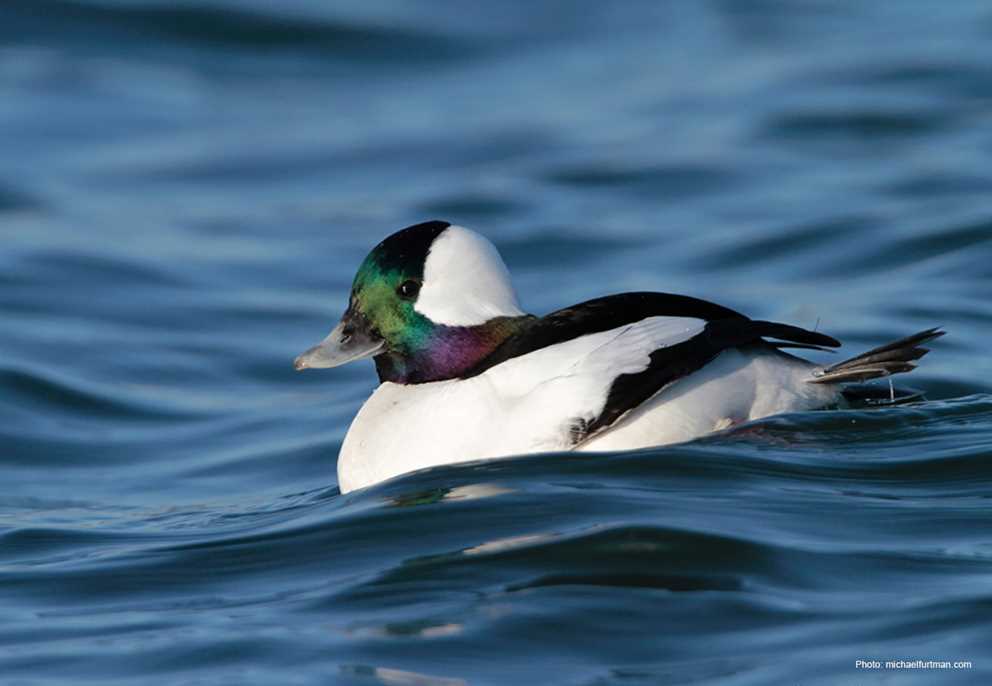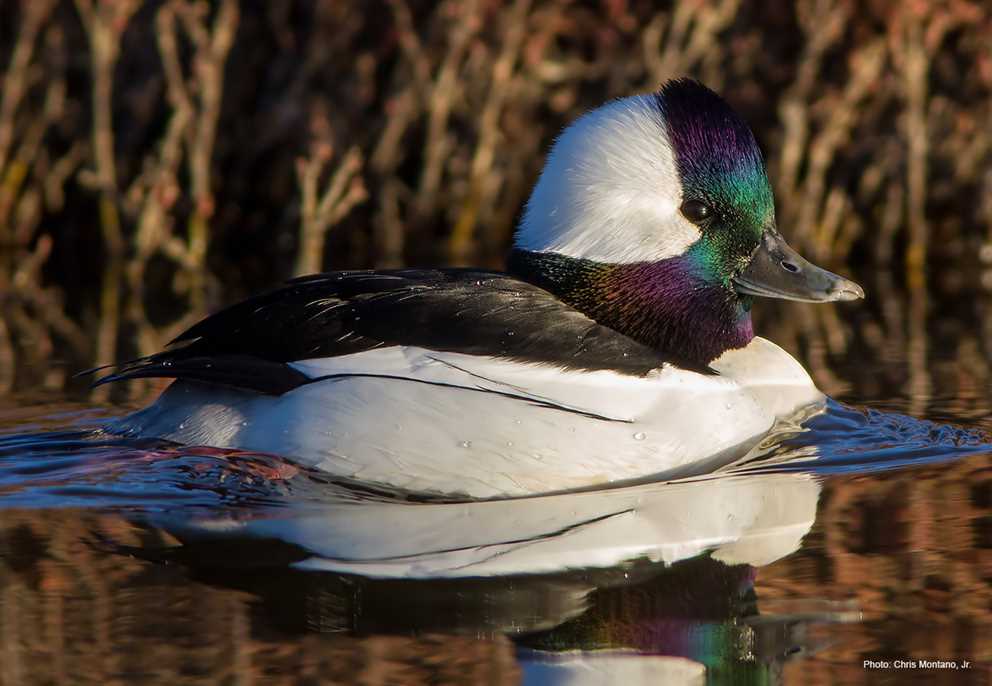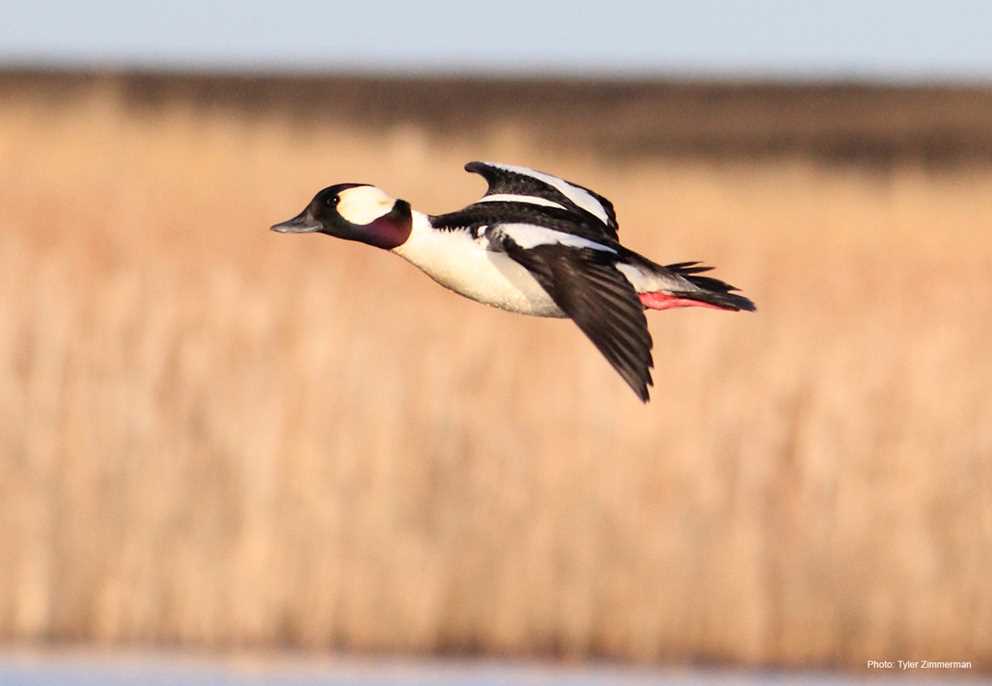Overview
The Bufflehead is are the smallest diving duck in North America and competes with the Green-winged Teal for the smallest species of duck on the continent. Its range is restricted to North America, where it breeds in boreal forest and aspen parkland areas. from British Columbia to eastern Quebec, with the core breeding area occurring in Alaska, Northwest Territories, British Columbia, and northern Alberta and Saskatchewan. In winter, they occur the length of the Pacific Coast from the Aleutians to Baja, Mexico, and from New Brunswick south to Florida and along the Gulf Coast. Wintering Buffleheads are also commonly seen on inland lakes and rivers, especially the Great Lakes.
Buffleheads are obligate cavity nesters, using boreal or aspen parkland lakes and wetlands, and often using cavities created by Northern Flickers. Buffleheads are monogamous, often keeping the same mate for several years. In migration and winter, they use shallow coastal bays and inlets, and inland lakes, where they feed heavily on crustaceans and mollusks. The population of Buffleheads is listed as least concern by the International Union for the Conservation of Nature. The total population is estimated at ~1.4 million, and surveys suggest they have increased since the 1950s.
Description
Key Identification Features:
- Buffleheads are small black and white diving ducks.
- In flight, Buffleheads have a very fast wing beat.
- Males have a large white head patch from the eye to the back of the head, with the remainder of the head black with iridescent green and purple overtones. The breast and sides are bright white, the belly gray, and the back is black. The wings are black but show a large white patch on the secondary coverts and feathers. The bill is pale blue gray.
- Females appear gray brown, have a small white patch on the head below and behind the eye, and the wings shows a white patch on the five innermost secondary feathers, and the bill is gray blue.
Male/Female Average Length and Weight
- Weight: Males 0.92–1.13 lbs.; Females 0.64–0.84 lbs.
- Wingspan: Males 6.7–6.9 in.; Females 6.0–6.3 in.
Male Identification
- Alternate (Breeding) Plumage: Head black with iridescent tones of green and purple, and a large white patch from behind eye to back of head. The neck, breast, sides and belly are white and the back and rump are black. The bill is blue gray. Head and neck brown-gray, with dull white on head behind eye. The back has wide long feathers and scapulars that are black in the middle and brown on the edges. Bill dark with yellowish tip.
- Basic Plumage: Head and neck brown-gray, with dull white on head behind eye. The back has wide long feathers and scapulars that are black in the middle and brown on the edges. Bill dark with yellowish tip.
- Head black with iridescent tones of green and purple, and a large white patch from behind eye to back of head. The neck, breast, sies and belly white, neck white, with gray back around eye, black ear patch, deep brown breast, back and rump black. The bill is blue gray.
Female Identification
- Alternate (Breeding) and Basic Plumage: The Contour plumage is brownish gray, the head is br Females app own with a white head patch present but smaller and duller, both plumages are similar.
In-Flight Identification
- Both sexes are small ducks, with white patches visible on the head, the patch more prominent in males. .
- Male: Similar to female, but with Males have white back and wing stripes much more prominent than the smaller white patch on the inner five secondary feathers of females..
Vocalizations
- Male Calls: Males give a loud chattering noise in courtship and may give a low squeal or growl in winter and spring.
- Female Calls: Females give a guttural “ec-ec-ec-ec” when nest prospecting, and an alarm call “cuc-cuc-cuc” to communicate danger to broods.
Similar Species
- Goldeneyes: Easily separated from Common Goldeneye and Barrow’s Goldeneye by size, and in male goldeneyes, their white head patch is forward of the eye near the base of the bill, compared to the large patch behind the eye in bufflehead males and females.
Habitat Preferences
- Breeding: Breeding Buffleheads are typically found on freshwater boreal and aspen parkland wetlands and lakes.
- Migration and Wintering: In migration and winter, Buffleheads use nearshore marine habitats of the Pacific Coast from the Aleutian Islands to Baja Mexico. They also winter along the Atlantic Coast from New Brunswick to Florida and the Gulf Coast. They are also fairly common on the Great Lakes and other larger inland lakes and reservoirs in winter.
Foraging Habits and Diet
- Buffleheads are diving ducks and forage extensively on invertebrates throughout the annual cycle.
- Breeding Season: During spring and summer, they primarily feed on aquatic insects, amphipods, and snails.
- Migration and Winter: In migration and winter, they consume a wide range of invertebrates, especially crustaceans, bivalves, and some fish and fish eggs.
Breeding Habits
- Monogamy: Buffleheads have serial or long-term monogamous mating systems. Males leave with onset of incubation, and pairs may re-unite on wintering areas. Courtship displays occur throughout the year except during molt and early fall, but most active pair formation is probably in late winter and spring. The age at first breeding is two years.
- Nest Locations: Buffleheads are obligate cavity nesters, using cavities created by Northern Flickers and sometimes Pileated Woodpeckers. They also readily use nest boxes. Nest initiation varies with latitude and date of spring thaw and may be as early as mid-April to mid-June. They have only one nest attempt per year. Nest in association with boreal and aspen parkland lakes and wetlands.
- Clutch Size: Clutch size averages of 6–11 eggs. The eggs are elliptical to oval, creamy white, yellowish-cream, or pale olive-buff, and are about 2 in. by 1.42 in. The incubation period is 28–33 days.
Migration and Distribution
- Fall Migration: Buffleheads depart their breeding areas and molting wetlands relatively late, usually in mid-to-late October. They arrive in migration and winter areas in November and December.
- Spring Migration: Spring migration is March to April with arrival on breeding areas in April, May, or early June.
Conservation Status
- IUCN Status: Least Concern
- Population Status: The North American population estimate is ~1.4 million birds and may have increased since the 1950s.
- Conservation Concerns: The primary threats include deforestation that reduces available nesting habitat.
- Conservation Focus: Conservation efforts include installation of nest boxes.
Harvest Information
- An average of 208,888 Buffleheads were harvested per season across the US during the 2019 through 2022 hunting seasons.
- Bufflehead harvest is typically highest in the Mississippi Flyway, accounting for 30 to 40 percent of the total US harvest.
- The top three harvest states for Buffleheads across the 2019–2022 hunting seasons were Michigan (73,204), Wisconsin (66,349), and California (65,265).
